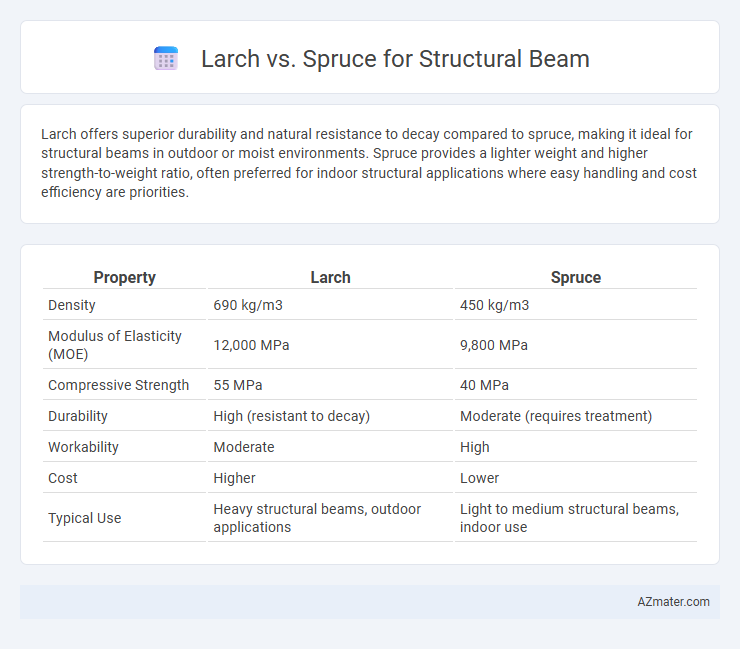Larch offers superior durability and natural resistance to decay compared to spruce, making it ideal for structural beams in outdoor or moist environments. Spruce provides a lighter weight and higher strength-to-weight ratio, often preferred for indoor structural applications where easy handling and cost efficiency are priorities.
Table of Comparison
| Property | Larch | Spruce |
|---|---|---|
| Density | 690 kg/m3 | 450 kg/m3 |
| Modulus of Elasticity (MOE) | 12,000 MPa | 9,800 MPa |
| Compressive Strength | 55 MPa | 40 MPa |
| Durability | High (resistant to decay) | Moderate (requires treatment) |
| Workability | Moderate | High |
| Cost | Higher | Lower |
| Typical Use | Heavy structural beams, outdoor applications | Light to medium structural beams, indoor use |
Introduction to Larch and Spruce as Structural Beams
Larch is a dense, durable softwood known for its high strength-to-weight ratio and natural resistance to decay, making it ideal for structural beams in outdoor and heavy-load applications. Spruce, a lightweight softwood with excellent strength and elasticity, offers consistent performance and ease of handling, commonly used in residential construction and framing. Both species provide reliable structural support, but larch's superior durability suits environments requiring long-lasting resistance to moisture and insects.
Botanical and Physical Overview
Larch (Larix spp.) is a deciduous conifer known for its dense, resin-rich wood with high stiffness and natural durability, making it ideal for structural beams exposed to moisture. Spruce (Picea spp.) features lightweight, straight-grained wood with excellent strength-to-weight ratio and uniform texture, commonly used in construction where predictable performance is required. Both species provide valuable structural properties, but larch's higher density and decay resistance offer advantages in outdoor or high-load applications.
Strength and Load-Bearing Capacity Comparison
Larch wood exhibits superior strength and higher load-bearing capacity compared to spruce, making it a preferred choice for structural beams in demanding construction projects. The dense grain and natural resin content of larch enhance its durability, providing better resistance to bending and compression forces. Spruce, while lighter and more workable, generally offers lower strength and stiffness, limiting its use in heavy-load structural applications.
Durability and Resistance to Decay
Larch wood offers superior durability and exceptional resistance to decay due to its high resin content, making it ideal for structural beams exposed to moisture. Spruce, while lighter and easier to work with, has lower natural decay resistance, requiring treatment for outdoor or high-moisture applications. The density of larch, typically ranging from 590 to 700 kg/m3, contributes to its strength and longevity compared to the softer spruce with densities around 400 to 470 kg/m3.
Workability and Machining Differences
Larch wood offers excellent workability due to its moderate density and fine grain, allowing for smoother cuts and easier shaping compared to spruce. Spruce, while lighter and generally easier to handle, can sometimes splinter during machining because of its more open grain structure. The inherent hardness of larch also provides better resistance to dents and wear, making it more suitable for structural beams requiring durability and precision in machining processes.
Moisture Content and Stability
Larch wood typically exhibits lower moisture content and higher natural resin levels, contributing to superior dimensional stability and resistance to warping when used as structural beams. Spruce tends to absorb and release moisture more readily, increasing the risk of swelling and shrinkage, which may compromise beam stability over time. Selecting larch for structural beams enhances durability and performance in environments with fluctuating humidity.
Cost and Availability in Construction Markets
Larch offers competitive pricing and is widely available in Northern and Eastern European construction markets, making it a cost-effective choice for structural beams. Spruce, often more abundant globally, tends to be less expensive due to its faster growth rate and broader distribution, especially in North America and Scandinavia. Availability of both woods varies regionally, influencing local market costs and impacting project budgets and material sourcing decisions for structural frameworks.
Environmental and Sustainability Considerations
Larch wood offers superior environmental benefits for structural beams due to its natural durability and slow growth, which supports carbon sequestration and reduces the need for chemical treatments compared to spruce. Spruce, while lightweight and strong, typically requires more frequent replacement and chemical preservation, potentially increasing environmental impact over its lifecycle. Selecting larch beams promotes sustainable forestry practices, as larch forests regenerate efficiently and contribute to biodiversity conservation.
Typical Applications in Structural Design
Larch wood is preferred for structural beams in heavy timber construction due to its high density, strength, and natural resistance to decay, making it ideal for outdoor frameworks, bridges, and load-bearing walls. Spruce, while lighter and easier to work with, is commonly used in residential framing, roof trusses, and interior structural supports where moderate strength and dimensional stability are required. Both species offer distinct advantages in structural design, with larch favored for durability and load capacity, and spruce chosen for cost-effectiveness and ease of installation.
Final Recommendations: Choosing Between Larch and Spruce
Larch offers exceptional durability and high density, making it ideal for structural beams in outdoor or high-moisture environments, while Spruce provides excellent strength-to-weight ratio and ease of handling for indoor construction. For projects requiring long-lasting resistance to decay and mechanical stress, larch beams are recommended; however, spruce is preferred for cost-effective, lightweight framing where environmental exposure is limited. Final selection depends on project-specific factors like load requirements, exposure conditions, and budget constraints.

Infographic: Larch vs Spruce for Structural Beam
 azmater.com
azmater.com